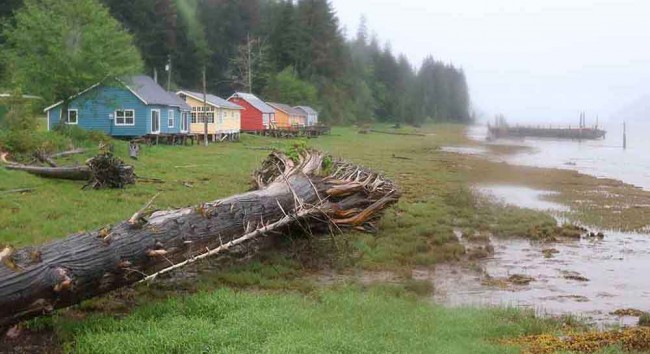
Photo Credit: Justine Crawford
Gone but not forgotten:Port Edward’s defunct canneries offer everything from history to beachcombing
A freight train rumbles past not 50 feet from our red-hued cottage, a throwback to an age when rail was the only way into this once-remote outpost on the northwest coast. Deflated, I learn that I could have been dropped at the door of my Cassiar Cannery accommodations if I had arranged in advance with VIA Rail.
Instead, I arrived the way of the modern traveller: car loaded with husband and one-year-old, bikes, baby chariot, laptop, multiple clothing changes and more than enough food for our two-day stay. We drove west under clear skies and, just before Prince Rupert, turned left, driving through Port Edward (pop. 500) and along a road that gently undulates—not just up and down with the rise and fall of the coastline, but the back-and-forth sway of a boat, as if it had been paved by a drunken sailor.
This 10-km stretch once boasted four canneries, each housing hundreds of residents: Cassiar, Sunnyside, North Pacific and Inverness. Of those, two still stand: The refurbished managers’ cottages at Cassiar are run as guesthouses, while North Pacific was made a National Historic Site in 1985 and averages 9,000 visitors each year. Sunnyside and Inverness both long since plunged into Inverness Passage, which runs between Port Edward and the Skeena estuary.
BC’s canneries once numbered in the hundreds, but today they are remembered in museums and refurbished accommodations such as these. Last year, the province’s last cannery closed when Prince Rupert’s Canfisco reduced operations to gutting and packing fish for processing elsewhere. Dwindling salmon stocks, consumer preference for fresh or frozen fish and international trade agreements are blamed for the closure, which cost the region several hundred jobs and spelled the end of an era.
Rainbow at the end of the road
Cassiar Cannery marks the end of the road with a row of rainbow-painted cottages overlooking the passage. Had we arrived by train, we would find ourselves a 25-minute drive from Prince Rupert with no vehicle, no cellphone coverage and no neighbours for several kilometres—making for the perfect getaway. Owners Justine Crawford and Mark Bell are capitalizing on their idyllic isolation by offering a variety of retreats: four women’s weekends this year, an annual Ecology Week in May, and plans for a writers’ retreat, couples’ retreat, fitness bootcamp and photography workshops.
When the couple bought the 74-acre property 10 years ago, it looked more like an abandoned, debris-filled junkyard than the thriving community it once was. The longest continuously running salmon cannery on the BC coast, Cassiar operated from 1903 until 1983. By 2006, it had been stripped of everything of value and fallen into neglect. Out of a half dozen cottages, some had power, some had water, but none had both. They camped in one as they made it their home and then continued to refurbish the Coho, Steelhead and Halibut cottages, as well as our own home away from home, Sockeye House.
The next morning, bluebird skies have given way to a soft, coastal mist as we set out to explore the area by bike, pedalling back toward Port Edward under old-growth spruce and hemlock forests. The bitter, distinctly coastal smell of skunk cabbage reminds us that tidewater lies a short distance away as we follow the tracks, which follow the passage.
Just a few kilometres from Cassiar a faint pathway through the undergrowth takes us to the pilings that once supported Sunnyside Cannery, which operated from 1916 until 1968. In 1986, it was burned for the filming of Trapper Jack and evidently little was salvaged before the blaze.
I’d envisioned our low-tide beachcombing mission as an exciting treasure hunt; instead, it’s impossible to step without your foot falling on a barnacle-encrusted piece of BC’s history—old bricks, Chinese medicine bottles and a cast-iron bathtub are just a few remnants so consumed by the sea as to only be recognizable by their distinctive shapes. I pocket a glass bottle and we return to the road.
Canned history
Next on our journey is North Pacific, the most extensively refurbished cannery on this strip, where I’m consumed by my love of old things: Rusty things. Broken things. Paint-peeling-in-multiple-layers things. I’m overtaken with faded-board-and-batten-and-rust-streaked-metal giddiness.
The cannery’s shabby-chic appeal has made it popular not only with history buffs, but photographers and event planners. Where fish guts once ran through wide-plank flooring to tidewater below, brides now swish their crinolines and tourists spend the day strolling boardwalks and sipping lattés.
“A lot of people just like to come out and walk the boardwalks, have a cup of coffee—even on the rainy days,” general manager Lesley Moore says. Whether a bright and sunny day or a moody, misty one, the cannery provides a place for reverie and the chance to peek into BC’s recent history.
Beginning in the late 1800s and operating as a cannery until 1968, North Pacific continued to process fish until the late 1970s. While much exterior restoration work has been completed, planning is currently underway for the restoration of building interiors. The bunkhouse, constructed in the early 1950s to house single men working at the cannery, offers hostel-style accommodation during the summer season.
From May through September, regular admission ($12 for adults) affords visitors the chance to tour the boardwalks and main canning building, which offers a self-guided tour, and a guided tour provides access to the general store and net loft, with its high ceilings, ethereal light and ghostly, hanging fishermen’s nets.
A new era
Continuing to Port Edward, we follow a narrow property that snakes along the passage where Inverness Cannery once sat. Today, it’s been divided into smaller lots, “for sale” signs adorning the trees as we glide past. One section is already occupied, its slopes boasting machinery and llamas. There’s little for the passing tourist, save a sign describing the cannery’s history as the first of its kind on the north coast until its closure in 1950 and ultimate demise—burned by kids—in 1973.
Sleepy Port Edward is part industrial, part bedroom community, part retirement hub for those intent on living out their lives on a fishing boat. Coal-filled train cars rumble below terraced lawns, a reminder that new resources now travel through this passage. Port Edward looks out at Lelu Island, the current focus of controversy for industry slated for the northwest coast: a proposed LNG terminal that could threaten the very salmon stocks that first attracted people here.
Before roads and rail, cannery operations provided an entire community for their workers, some of whom were Japanese brought over on contract (until Pearl Harbor, when they were sent to internment camps) or First Nations who travelled from as far north as the Stikine. The train came through in 1914 followed by the road in 1957, diminishing the canneries’ community as staff began to move off site.
Many who spent their childhoods here return today to reminisce: “For a lot of people it was their favourite time of their lives,” Crawford says about the steady employment and strong social fabric offered by the canneries.
“I find this place really timeless. The days go really fast.”
This morning’s gentle rain has turned to a steady downpour as we head back to our cozy cottage, where a warm shower and bowl of soup await. It’s easy to pass the afternoon lodged on our cottage’s couch, staring out at the passage where otters play and eagles soar. Indeed, it does boast a sense of timelessness.
More than ever, I wish I’d taken the train.






